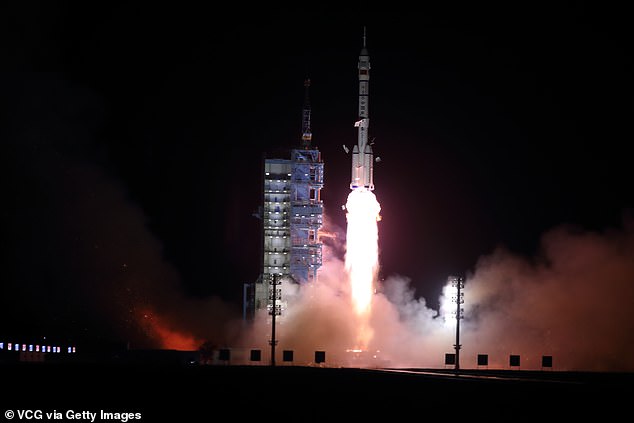Moment: A CHINESE missile explodes over California after red reentry through Earth’s atmosphere – months after the spy balloon fiasco
Californians got a shock in the early hours of Tuesday morning when golden streaks from an apparent explosion appeared over Los Angeles.
Locals believed it was the SpaceX Falcon 9 rocket that launched six hours earlier, or a giant meteor that ignited as it shot through Earth’s atmosphere.
Aerospace researchers determined that the fiery object was the orbital object of China’s Shenzhou-15 rocket launched in 2022.
The space junk, owned by China, comes just months after the country infiltrated the US by flying a spy balloon over an air base in Montana.
A piece of the Shenzhou-15 rocket (pictured) exploded over California on Tuesday morning
The 3,300-pound orbital module, a secondary part of the rocket, was not designed to safely enter Earth’s atmosphere and would orbit our planet along with tons of other space debris.
Witnesses to the explosion posted videos on social media showing the object flying through the sky around 1:40 a.m. PT, wondering what it was.
One person wrote on
When news emerged that it was a piece of a Chinese missile, comments about the country’s involvement began pouring in.
“China just does what they want there.” wrote one person on X.
Another person commented: ‘Someone in China is getting fired today. Not because it (the rocket) crashed near LA, but because it missed.”
The Aerospace Corporation – a federally funded aerospace research and development center – told the BBC that despite speculation that the explosion belonged to SpaceX, an analysis showed it was not a US rocket.
Instead, the nonprofit said, “Our analysis suggests that the object seen re-entering Los Angeles this morning was the orbital module of China’s Shenzhou-15 launch in November 2022 to their space station.”

The Shenzhou-15 rocket carried three astronauts when it lifted off from Mongolia in November 2022
The 17,857-pound Shenzhou-15 rocket consists of multiple modules, including the reentry module that returns astronauts safely to Earth and the service section that houses hardware such as solar panels and life support necessary for the mission.
The third section of Shenzhou-15, the orbital module, is a living quarters for astronauts and houses scientific instruments, crew-operated equipment and other types of cargo needed for the mission.
In November 2022, China’s Shenzhou-15 rocket was launched with three astronauts on board from the Jiuquan Satellite Launch Center in the Gobi Desert, Mongolia to the Tiangong Space Station to complete the construction of the country’s orbital outpost.
Shenzhou-15’s reentry module landed safely in June last year and according to data from the Aerospace Corporation tracking siteit predicted that the return time of the Shenzhou-15 orbital module would be at 01:33 GMT on Tuesday.
According to University of Southern California space expert Madhu Thangavelu, there are no reports yet that any debris from the orbital module has crashed on land and some of it may have landed in the Pacific Ocean.
He told the BBC that he “hopes everything in the upper atmosphere has burned up.”
This isn’t the first time one of China’s missiles has gone rogue.
The sight of a Chinese missile in US airspace may have brought back memories of the spy balloon that appeared in the Midwest in 2023.
The balloon had drifted eastward and entered U.S. airspace over Alaska on Jan. 28 and was tracked as it flew over Malmstrom Air Force Base in Montana, where nuclear assets are stored.
Intelligence officials revealed in December that the balloon used a U.S. Internet service provider to communicate.
The report said the balloon was connected to a US-based company and communicated with China regarding its navigation.
It further stated that the connection “enabled the balloon to send burst transmissions or high-bandwidth data collections over short periods of time” to its home base in China.
